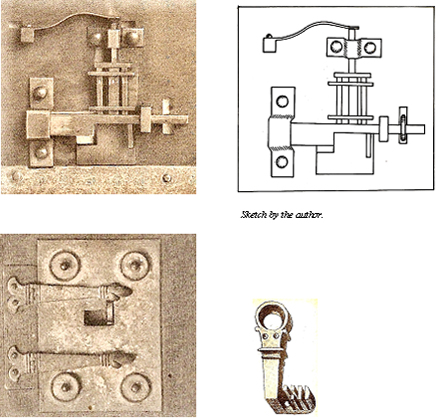Roman door locks
The wooden Egyptian pin tumbler locks were over two thousand years old by this time. Roman engineers modernized them and other lock constructions by replacing the wooden parts with corresponding parts made of metal.
The clumsy Egyptian pin tumbler locks were transformed into elegant Roman pin tumbler locks of steel, fitted with an ingenious Roman invention, steel springs. The locks were often tiny masterpieces in terms of both precision and design. All Roman door locks can only be opened from one side.
The two pictures above show reconstructions of a pin tumbler lock and key from one of the earliest archeological digs in Pompeii. They were illustrations in Le case e monumenti di Pompeii, four volumes by Fausto and Felice Niccolini, printed in Naples in 1854–96. Another author, Albert Neuburger, used the same images in his book on ancient technology, Die Technik des Altertums, printed in Leipzig in 1921. The cities of Pompeii and Herculaneum were buried in ash when the nearby volcano Mount Vesuvius erupted in 79 AD, and were eventually forgotten.
Not until 1763, when parts of buildings and inscriptions bearing the name of Pompeii were unearthed during the digging of a canal, was the city identified. The area was immediately expropriated by King Charles III, who had workers dig for artefacts for his private art collection. Scientific investigations of the site did not begin until a bit into the 19th century. Cultural tourists have been visiting the area since the first digs began, including a teenager named W A Mozart, who visited the site with his father Leopold in 1770.
 |
| Illustrations in Technik des Altertums. Reconstruction of a Roman pin tumbler door lock of metal, inside and outside, and an example of a key. Deutsches Museum, Munich. The first reconstruction of this lock was made by Louis Jacobi (1836–1910) for the Saalburg Museum north of Frankfurt. |